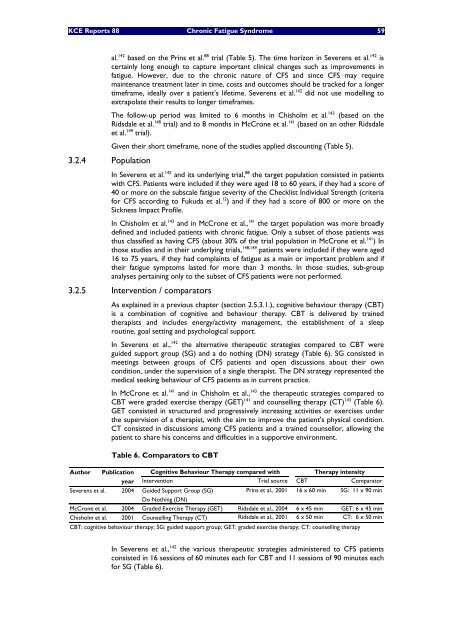Chronisch Vermoeidheidssyndroom: diagnose, behandeling en ...
Chronisch Vermoeidheidssyndroom: diagnose, behandeling en ...
Chronisch Vermoeidheidssyndroom: diagnose, behandeling en ...
You also want an ePaper? Increase the reach of your titles
YUMPU automatically turns print PDFs into web optimized ePapers that Google loves.
KCE Reports 88 Chronic Fatigue Syndrome 59<br />
al. 142 based on the Prins et al. 88 trial (Table 5). The time horizon in Sever<strong>en</strong>s et al. 142 is<br />
certainly long <strong>en</strong>ough to capture important clinical changes such as improvem<strong>en</strong>ts in<br />
fatigue. However, due to the chronic nature of CFS and since CFS may require<br />
maint<strong>en</strong>ance treatm<strong>en</strong>t later in time, costs and outcomes should be tracked for a longer<br />
timeframe, ideally over a pati<strong>en</strong>t’s lifetime. Sever<strong>en</strong>s et al. 142 did not use modelling to<br />
extrapolate their results to longer timeframes.<br />
The follow-up period was limited to 6 months in Chisholm et al. 143 (based on the<br />
Ridsdale et al. 148 trial) and to 8 months in McCrone et al. 141 (based on an other Ridsdale<br />
et al. 149 trial).<br />
Giv<strong>en</strong> their short timeframe, none of the studies applied discounting (Table 5).<br />
3.2.4 Population<br />
In Sever<strong>en</strong>s et al. 142 and its underlying trial, 88 the target population consisted in pati<strong>en</strong>ts<br />
with CFS. Pati<strong>en</strong>ts were included if they were aged 18 to 60 years, if they had a score of<br />
40 or more on the subscale fatigue severity of the Checklist Individual Str<strong>en</strong>gth (criteria<br />
for CFS according to Fukuda et al. 12 ) and if they had a score of 800 or more on the<br />
Sickness Impact Profile.<br />
In Chisholm et al. 143 and in McCrone et al., 141 the target population was more broadly<br />
defined and included pati<strong>en</strong>ts with chronic fatigue. Only a subset of those pati<strong>en</strong>ts was<br />
thus classified as having CFS (about 30% of the trial population in McCrone et al. 141 ) In<br />
those studies and in their underlying trials, 148,149 pati<strong>en</strong>ts were included if they were aged<br />
16 to 75 years, if they had complaints of fatigue as a main or important problem and if<br />
their fatigue symptoms lasted for more than 3 months. In those studies, sub-group<br />
analyses pertaining only to the subset of CFS pati<strong>en</strong>ts were not performed.<br />
3.2.5 Interv<strong>en</strong>tion / comparators<br />
As explained in a previous chapter (section 2.5.3.1.), cognitive behaviour therapy (CBT)<br />
is a combination of cognitive and behaviour therapy. CBT is delivered by trained<br />
therapists and includes <strong>en</strong>ergy/activity managem<strong>en</strong>t, the establishm<strong>en</strong>t of a sleep<br />
routine, goal setting and psychological support.<br />
In Sever<strong>en</strong>s et al., 142 the alternative therapeutic strategies compared to CBT were<br />
guided support group (SG) and a do nothing (DN) strategy (Table 6). SG consisted in<br />
meetings betwe<strong>en</strong> groups of CFS pati<strong>en</strong>ts and op<strong>en</strong> discussions about their own<br />
condition, under the supervision of a single therapist. The DN strategy repres<strong>en</strong>ted the<br />
medical seeking behaviour of CFS pati<strong>en</strong>ts as in curr<strong>en</strong>t practice.<br />
In McCrone et al. 141 and in Chisholm et al., 143 the therapeutic strategies compared to<br />
CBT were graded exercise therapy (GET) 141 and counselling therapy (CT) 143 (Table 6).<br />
GET consisted in structured and progressively increasing activities or exercises under<br />
the supervision of a therapist, with the aim to improve the pati<strong>en</strong>t's physical condition.<br />
CT consisted in discussions among CFS pati<strong>en</strong>ts and a trained counsellor, allowing the<br />
pati<strong>en</strong>t to share his concerns and difficulties in a supportive <strong>en</strong>vironm<strong>en</strong>t.<br />
Table 6. Comparators to CBT<br />
Author Publication Cognitive Behaviour Therapy compared with Therapy int<strong>en</strong>sity<br />
year Interv<strong>en</strong>tion Trial source CBT Comparator<br />
Sever<strong>en</strong>s et al. 2004 Guided Support Group (SG)<br />
Do Nothing (DN)<br />
Prins et al., 2001 16 x 60 min SG: 11 x 90 min<br />
McCrone et al. 2004 Graded Exercise Therapy (GET) Ridsdale et al., 2004 6 x 45 min GET: 6 x 45 min<br />
Chisholm et al. 2001 Counselling Therapy (CT) Ridsdale et al., 2001 6 x 50 min CT: 6 x 50 min<br />
CBT: cognitive behaviour therapy; SG: guided support group; GET: graded exercise therapy; CT: counselling therapy<br />
In Sever<strong>en</strong>s et al., 142 the various therapeutic strategies administered to CFS pati<strong>en</strong>ts<br />
consisted in 16 sessions of 60 minutes each for CBT and 11 sessions of 90 minutes each<br />
for SG (Table 6).

















